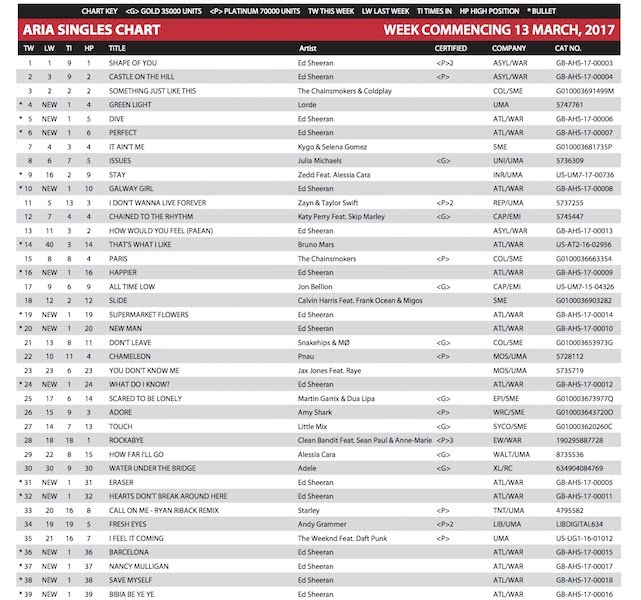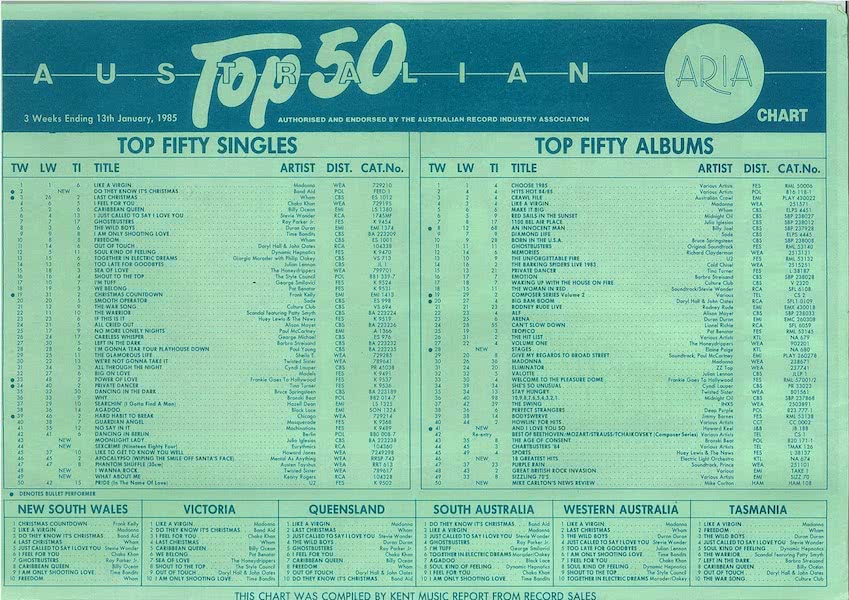The ARIA Chart is dead! Long live the ARIA Chart! [Op-Ed]
![The ARIA Chart is dead! Long live the ARIA Chart! [Op-Ed]](https://images.thebrag.com/cdn-cgi/image/fit=cover,width=1200,height=800,format=auto/https://images-r2-1.thebrag.com/tmn/uploads/2018/05/ariacharts.jpg)
Like many in the music industry, I grew up with the ARIA Charts as my bible as a kid. A #1 on the ARIA Chart really meant something.
You’d head to the record store (remember them?) every week and pick up a copy of the printed chart and pour over it to see what went up, what went down and who the all-important #1 would be for that week. You’d listen to Take 40 Australia to hear the records spin in order, or get up at 4am to watch Rage to make sure you caught what #50 was.
Fast forward to 2018 and industry commentators are asking the question of how the charts could be left to get this broken, when first Ed Sheeran and now Post Malone can dominate the chart with every song off an album debuting in the singles list, rendering it apparently irrelevant.
How can this farce be left to continue and sully the sacred tradition of the ARIA Chart? All of a sudden, the long-held basis of our chart being about sales has been bastardised with streaming and is no longer a true reflection of a song’s popularity. How can you compare Ed Sheeran and Post Malone with The Beatles or ABBA?

ARIA Chart week commencing 13 March 2017
I’ve got a secret for you
The ARIA Charts were always a bastard child of commerce. They aren’t the pristine bastions of reality some would have you believe.
In the ’80s it was about bribing record stores to report sales on their faxed-in sheets. In the ’90s it was about selling singles for 99c so they’d rocket up the charts. It was about deleting #1 singles while they were still at the top and adding a remix of the onto the act’s crappy second single so that it would piggy-back on its success and give an otherwise one-hit-wonder-bound act a limp second effort that might vainly tip over a few album sales.

ARIA Chart January 13, 1985
In the ’00s it was all computerised so you could no longer bribe the retailer. Except you still could. And that 99c single thing? Now you could take a mini bus of school kids around and buy them up yourselves as you went from retailer to retailer to add that extra realism to the scam as they scanned the sales into the computer.
But hey. Everyone’s going to try to manipulate things from time to time. At least at their heart (give or take a few scams from desperate record companies), the charts were based on real popularity. Real sales.
Well hang on a minute. How many times have you bought a record and got it home and never played it? How many times have you been to a show and seen a support band and said, “hey they are awesome” and bought the CD on the way home before waking up in the morning and realising you were smashed and the band sucked?
How many times have you bought a copy of Michael Buble for your Grandma for Mother’s Day and she didn’t know how to work the CD player anyway.
The idea that sales are a proxy for popularity was always a furphy
This is made clear with all the reasons outlined above and more. Does that mean the ARIA Chart was a farce? Well I would argue no. It was the best way we had to measure it at the time and for whatever funny business was happening out there to manipulate things, at the heart of it, the ARIA Charts have been run with serious rules and a team that takes their job very seriously.
Whatever their failings, they have always been the best possible measure of the recorded music industry that we’ve had at the time given the technology and commercial realities of the day. And today is no different.
There is no question that the charts are at a crossroads as we walk across that bridge between a buyer’s world and a consumer’s world, and there’s some weird ass things happening when compared to historical charts.
But why? It’s because the whole industry is walking that bridge and the ARIA Charts are simply a reflection of the industry we are today.
I would argue there are definitely some evolutionary things to iron out in the chart calculations. Right now, the charts are half pregnant in their switch between sales and consumption and that will eventually change.
Philosophically, the decision has been made that streaming and therefore consumption is a legitimate metric for charting. I applaud this and it was of course inevitable as we move towards a world without music ownership.
The problem with this is that while we’ve let streaming in, we are treating it as if it’s the same as a sale when rather than tinkering around the edges and pretending a number of streams equal a sale, we need a proper re-think. You can’t let some consumption in without broadening the base and as the system evolves, we shouldn’t continue to treat all consumption as equal.
The psychology behind a stream can be very different
The popularity of a song where someone has typed in the name of the song they want to listen to and actively consumed is not the same as one that happens to spin around because it’s track nine on the Chill Out playlist you clicked on before you jumped in the pool.
Despite that, right now both “streams” in that example are weighted equally. And on top of that, while you may now use Spotify as your ‘radio station’ and the fact turning on New Music Friday is counting for the chart, what about the 100,000-odd people who tune in to Richard Kingsmill’s show on triple j, or Ash London on Hit as their own New Music Friday (or Sunday or Monday, but you get my point)?
What makes their consumption less worth counting than the punter on Spotify simply because they choose the radio as their listening platform?
Stream New Music Friday on Spotify below
As calculations have become more sophisticated, we know that it’s possible to tell the difference between a “lean back” (a listen you didn’t specifically choose) and a “lean forward” (something you searched for or play off your personal playlist) stream. So let’s explore weighting them differently.
Perhaps that’s not data that can be shared commercially for chart calculations, but let’s look at the possibilities. Then let’s broaden the data set.
Why not add in radio data? Why not add in songs that are being spun across pubs, gyms and clubs? The US charts have counted radio airplay for years.
If the time has come where the chart now measures real popularity via consumption rather than sales, we need to broaden the base to capture that consumption and be ever willing to look at new data sets that may pop up to include in the metrics. Maybe even look at other measures of popularity like Shazam.
The technical details of these things may take months or even years to work out, but the decision that the charts can now be based on consumption and popularity rather than the narrow lens of “sales” has already been taken. Now let’s take it further.
We shouldn’t be scared of evolving the algorithm
And while we’re at it, it’s definitely time to re-weight the chart to better reflect the serious “lean forward” impact of a sale. In a world where everything is at your fingertips for free, is spending your hard-earned $20 on a CD really worth just the equivalent of a couple of hundred lean-back streams? Let’s give a sale the gravitas that it deserves and review the sale to stream weighting.
With a wholesale review of the weighting of streams vs sales, a look at whether it’s possible to weight lean-back vs lean-forward streams differently – and a broadening of the base to include radio and other public performance uses in the chart – the criticisms of having a dozen Post Malone songs “clogging up” the chart may well be quelled through a broader data set that may give a more robust result.
We love Post Malone, but him having 17 songs in this week’s Top 50 ARIA Singles chart is clearly ruining the validity of the chart. He has a wildly successful album, which is reflected in its #1 debut this week. It shouldn’t spill onto the singles chart. https://t.co/5d66whYcPs pic.twitter.com/qAOKsmsJLl
— TheIndustryObserver (@theindustry_o) May 7, 2018
And you know what? Maybe a shitload of people all over Australia listened to a shitload of Post Malone songs last week and he wasn’t “clogging up” the chart, he was legitimately that popular and deserves the accolades.
Maybe ABBA deserved 12 songs in the chart at once as well, but the record company just didn’t release the 7” for every song, so the chart couldn’t reflect the reality of culture at the time. Now it can.
Let’s keep trying to make the chart better, but let’s stop pretending like the world was better “back in my day”. The charts have always been the best way we’ve had of measuring the popularity of records at any given time in history.
While I nostalgically miss the days of dashing in to Brashes to grab the chart while Mum did the groceries and the store manager was out the back doctoring up 50 sales of ‘Euphoria’ cassingles because his rep gave him a bottle of scotch, I am pretty confident that the ARIA Chart of 2018 is a far better judge of what’s popular than the ARIA Chart of 1992 was. And I’m confident the ARIA Chart of 2028 will be even better again.
It’s not perfect. It never will be.
But as long as it keeps evolving, we’ll still say it doesn’t matter and it’s all a farce when it suits our egos, but it’ll still be the truest measure of commercial success after a hard week in the recorded music game.
Now’s not the time to give up on the chart. It’s time to celebrate it, double down and make it even better.
This article originally appeared on The Industry Observer, which is now part of The Music Network.






























